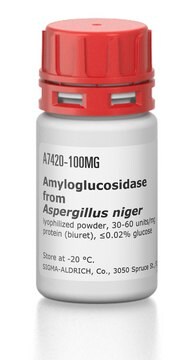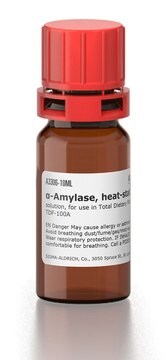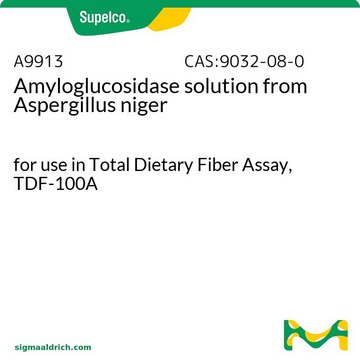Wszystkie zdjęcia(1)
Kluczowe dokumenty
A7095
Amyloglucosidase from Aspergillus niger
≥260 U/mL, aqueous solution
Synonim(y):
AMG 300L™, 1,4-α-D-Glucan glucohydrolase, Exo-1,4-α-glucosidase, Glucoamylase
Zaloguj sięWyświetlanie cen organizacyjnych i kontraktowych
About This Item
Numer CAS:
Numer MDL:
Kod UNSPSC:
12352204
NACRES:
NA.54
Polecane produkty
pochodzenie biologiczne
Aspergillus niger
Poziom jakości
Formularz
aqueous solution
aktywność właściwa
≥260 U/mL
gęstość
~1.2 g/mL at 25 °C
temp. przechowywania
2-8°C
Szukasz podobnych produktów? Odwiedź Przewodnik dotyczący porównywania produktów
Opis ogólny
Stabilized with glucose.
Amyloglucosidase is a disaccharidase−type alpha-glucosidase, produced by several species of Aspergillus genus. Immobilization of amyloglucosidase is known to increased its stability.
Amyloglucosidase is a disaccharidase−type alpha-glucosidase, produced by several species of Aspergillus genus. Immobilization of amyloglucosidase is known to increased its stability.
Zastosowanie
Amyloglucosidase from Aspergillus niger has been used in in vitro digestions. It has also been used in the isolation of insoluble and soluble dietary fibre from quinoa and amaranth.
Działania biochem./fizjol.
Amyloglucosidase from Aspergillus niger is capable of hydrolyzing the α-D-(1-4), the α-D-(1-6), and the α-D-(1-3) glucosidic bonds of oligosaccharides. Amyloglucosidase is an extracellular enzyme that converts starch to dextrins and glucose. The enzyme is used in the starch-processing industry for the commercial production of D-glucose from corn syrups.
Inne uwagi
View more information on enzymes for complex carbohydrate analysis at www.sigma-aldrich.com/enzymeexplorer
Informacje prawne
A product of Novozymes Corp.
AMG is a trademark of Novozymes Corp.
Ta strona może zawierać tekst przetłumaczony maszynowo.
Hasło ostrzegawcze
Danger
Zwroty wskazujące rodzaj zagrożenia
Zwroty wskazujące środki ostrożności
Klasyfikacja zagrożeń
Resp. Sens. 1
Kod klasy składowania
10 - Combustible liquids
Klasa zagrożenia wodnego (WGK)
WGK 3
Wybierz jedną z najnowszych wersji:
Masz już ten produkt?
Dokumenty związane z niedawno zakupionymi produktami zostały zamieszczone w Bibliotece dokumentów.
Klienci oglądali również te produkty
Biodiversity: New Leads for the Pharmaceutical and Agrochemical Industries, 12(5), 183-183 (2000)
Effect of two barley beta-glucan concentrates on in vitro glycaemic impact and cooking quality of spaghetti
Chillo, S and Ranawana, DV and Henry, CJK
Food Sci. Technol., 44(4), 940-948 (2011)
Quinoa (Chenopodium quinoa W.) and amaranth (Amaranthus caudatus L.) provide dietary fibres high in pectic substances and xyloglucans
Lamothe Lisa M, et al.
Food Chemistry, 167(4), 490-496 (2015)
Recent Advances in Basic and Applied Aspects of Industrial Catalysis, 891-891 (1998)
Fandila Carlos-Amaya et al.
Journal of agricultural and food chemistry, 59(4), 1376-1382 (2011-01-11)
Banana starch was chemically modified using single (esterification or cross-linking) and dual modification (esterification-cross-linking and cross-linking-esterification), with the objective to increase the slowly digestible starch (SDS) and resistant starch (RS) concentrations. Physicochemical properties and in vitro digestibility were analyzed. The
Nasz zespół naukowców ma doświadczenie we wszystkich obszarach badań, w tym w naukach przyrodniczych, materiałoznawstwie, syntezie chemicznej, chromatografii, analityce i wielu innych dziedzinach.
Skontaktuj się z zespołem ds. pomocy technicznej










